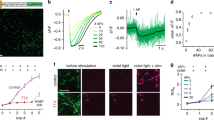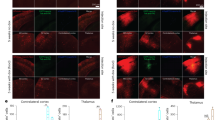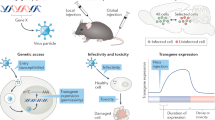Abstract
We developed retrograde, transsynaptic pseudorabies viruses (PRVs) with genetically encoded activity sensors that optically report the activity of connected neurons among spatially intermingled neurons in the brain. Next we engineered PRVs to express two differentially colored fluorescent proteins in a time-shifted manner to define a time period early after infection to investigate neural activity. Finally we used multiple-colored PRVs to differentiate and dissect the complex architecture of brain regions.
This is a preview of subscription content, access via your institution
Access options
Subscribe to this journal
Receive 12 print issues and online access
$259.00 per year
only $21.58 per issue
Buy this article
- Purchase on Springer Link
- Instant access to full article PDF
Prices may be subject to local taxes which are calculated during checkout



Similar content being viewed by others
References
Wickersham, I.R. et al. Neuron 53, 639–647 (2007).
Smith, B.N. et al. Proc. Natl. Acad. Sci. USA 97, 9264–9269 (2000).
Jons, A. & Mettenleiter, T.C. J. Virol. Methods 66, 283–292 (1997).
Boldogkoi, Z., Erdelyi, F., Sik, A., Freund, T.F. & Fodor, I. Luminescence 14, 69–74 (1999).
Banfield, B.W., Kaufman, J.D., Randall, J.A. & Pickard, G.E. J. Virol. 77, 10106–10112 (2003).
Viney, T.J. et al. Curr. Biol. 17, 981–988 (2007).
Heim, N. & Griesbeck, O. J. Biol. Chem. 279, 14280–14286 (2004).
Bartha, A. Magyar Allatorvosok Lapja 16, 42–45 (1961).
Kaplan, A.S. & Vatter, A.E. Virology 7, 394–407 (1959).
Husak, P.J., Kuo, T. & Enquist, L.W. J. Virol. 74, 10975–10983 (2000).
Pickard, G.E. et al. J. Neurosci. 22, 2701–2710 (2002).
De Paola, V., Arber, S. & Caroni, P. Nat. Neurosci. 6, 491–500 (2003).
Heim, N. et al. Nat. Methods 4, 127–129 (2007).
Hattar, S. et al. J. Comp. Neurol. 497, 326–349 (2006).
Provencio, I., Rollag, M.D. & Castrucci, A.M. Nature 415, 493 (2002).
Baver, S.B., Pickard, G.E., Sollars, P.J. & Pickard, G.E. Eur. J. Neurosci. 27, 1763–1770 (2008).
Zemanick, M.C., Strick, P.L. & Dix, R.D. Proc. Natl. Acad. Sci. USA 88, 8048–8051 (1991).
Mank, M. et al. A genetically encoded calcium indicator for chronic in vivo two-photon imaging. Nat. Methods 5, 805–811 (2008).
Pomeranz, L.E., Reynolds, A.E. & Hengartner, C.J. Microbiol. Mol. Biol. Rev. 69, 462–500 (2005).
Acknowledgements
We thank S. Djaffer for technical assistance. The following researchers provided materials: I. Provencio (University of Virginia, Charlottesville), melanopsin antibody; D.W. Piston (University of Maryland School of Medicine, Baltimore), vector encoding mCerulean; P. Caroni (Friedrich Miescher Insitute, Basel), vector encoding MARCKS-GFP and pThy1-mEGFP vector; R.E. Campbell (University of Alberta, Edmonton), vector encoding mTFP1; R.Y. Tsien (University of California, San Diego), vectors encoding mRFP1 and mCherry; R.H. Scheller (Genentech), vector encoding VAMP-GFP; O. Griesbeck (Max Planck Institute of Neurobiology, Martinsried), vector encoding TN-L15. F. Rijli commented on the manuscript. This study was supported by Novartis Research Foundation funds, US Office of Naval Research Naval International Cooperative Opportunities in Science and Technology Program grant, Marie Curie Excellence grant and Human Frontiers Science Program Young Investigator grant to B.R.; Hungarian National Fund for Scientific Research and Human Frontiers Science Program Young Investigator grant to Z.B.; Swiss National Center of Competence in Research in Genetics fellowship to V.B.; and Human Frontiers Science Program fellowship to G.B.A.
Author information
Authors and Affiliations
Contributions
K.B., E.P., D.T., J.S.T., I.F.T., V.B., P.S.L. and B.G.S. engineered the plasmids. Z.B. made the PRVs. K.B. performed PRV injections, time-lapse, two-photon and confocal imaging, and electrophysiological experiments as well as immunohistochemistry and data analysis. G.B.A. helped with two-photon imaging and electrophysiological experiments. D.B. wrote the data acquisition and analysis software for two-photon microscopy. T.J.V. helped with Ti-PRV injections. J.D. built the two-photon microscope. B.R., Z.B., K.B. and G.B.A. designed the experiments.
Corresponding author
Ethics declarations
Competing interests
K.B., Z.B. and B.R. are authors on a European patent application 08 152 609.7 that covers the work described in the manuscript.
Supplementary information
Supplementary Text and Figures
Supplementary Figures 1–3, Supplementary Tables 1–4, Supplementary Results, Supplementary Methods (PDF 1111 kb)
Rights and permissions
About this article
Cite this article
Boldogkői, Z., Balint, K., Awatramani, G. et al. Genetically timed, activity-sensor and rainbow transsynaptic viral tools. Nat Methods 6, 127–130 (2009). https://doi.org/10.1038/nmeth.1292
Received:
Accepted:
Published:
Issue Date:
DOI: https://doi.org/10.1038/nmeth.1292
This article is cited by
-
Multicolor strategies for investigating clonal expansion and tissue plasticity
Cellular and Molecular Life Sciences (2022)
-
The Glutamatergic Postrhinal Cortex–Ventrolateral Orbitofrontal Cortex Pathway Regulates Spatial Memory Retrieval
Neuroscience Bulletin (2019)
-
Trans-synaptic Neural Circuit-Tracing with Neurotropic Viruses
Neuroscience Bulletin (2019)
-
Transcriptome-wide survey of pseudorabies virus using next- and third-generation sequencing platforms
Scientific Data (2018)
-
Microglia control the spread of neurotropic virus infection via P2Y12 signalling and recruit monocytes through P2Y12-independent mechanisms
Acta Neuropathologica (2018)



